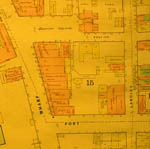 |
 |
 |
 |
 |
 |
 |
In the spring of 1778 Captain James Cook, of the Royal Navy, became the first European to set foot on what is now Vancouver Island. A maritime fur trade developed between the local Coast Salish people sparking economic interest on the northwest coast by the British, Americans, and Russians. As the maritime fur trade faded from the economic forefront, British interests in the Pacific Northwest remained for the purpose of establishing a naval presence in the Pacific and prevention of Russian and American encroachment. The land based fur trade, spreading west from Canada, sparked another era of economic interest and brought the penetration of Europeans over land to the Pacific coast. On March 14, 1843, Chief Factor of the Hudson's Bay Company James Douglas established Fort Camosun (referring to the native name of the area, "Camosack", meaning "Rush of Water"). Later renamed Fort Victoria in honour of the British Queen, the trading post quickly established a trade network with the island’s Native population. In order to support the presence of the British fur trading company and prevent American encroachment on the fur bearing territory, the Hudson’s Bay Company received title, by Royal Grant, of the whole of Vancouver Island on January 13, 1849. The British Government gave this land to the company on the condition that colonization would be undertaken at the expense of the company in order to legitimize British claim to the land and its resources. By the summer of the same year, Chief Factor James Douglas resided in Fort Victoria to begin the task of colonization with the help of his fur trade colleagues. Constitutional history of Fort Victoria began in 1849 with the development of the Imperial government of the crown colony of Vancouver Island. On March 11, 1850, Richard Blanshard formally assumed the position of Governor of the colony of Vancouver Island; no longer was the fur trade the driving force of the colony. British colonists gathered around the fort to hear the newly arrived governor Blanshard read the Royal Commission, appointing him the governor of the first crown colony to be established west of the Great Lakes. Blanshard's short tenure proved disappointing from the start and lasted for only a year and a half while Douglas remained a prominent figure in the operation of the colony. In Blashard's resignation, the British Government appointed Douglas as the Governor of Vancouver Island despite his potentially conflicting position of HBC Chief Factor. Community life of Victoria, numbering approximately 450 Europeans in 1853 revolved around the business of the HBC and its fur trade until the discovery of gold on the Fraser River in 1858. Miners, adventurers, and business prospectors flowed into Victoria from all around the world to be outfitted for the demanding search of gold. While most originated from the gold fields of California, many prospectors originated from Europe, Australia and China. An American steamer, the “Commodore”, cruised into Victoria harbour on the Sunday of April 25, 1858. With amazement, Victorian settlers and natives alike watched as 450 men disembarked the American ship, many already equipped with blankets, shovels, pans, and firearms. The Commodore was the first of many boats on route for Victoria harbour and it is estimated that within weeks, 20,000 miners had landed. The gold rush was in full swing and Victoria was its stepping-stone. Although the great majority of these miners were merely transient, their flowing numbers transformed Victoria from a fur trade town into a bustling center of business. So rapidly were the Hudson’s Bay Company warehouses replaced by dozens of stores and offices. Soon, elaborate government offices, a theatre, and gas street lamps were to adorne the streets and society of Victoria. |